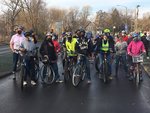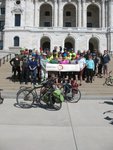

The bicycle system in St. Paul is improving each year, in part due to the advocacy of the St. Paul Bicycle Coalition.
Co-chairs Andy Singer and Ian Buck point to the increased number of bicycle lanes, protected bike lanes and off-street trails that have been added in recent years.
Last year the city completed six major bike projects – four off-street trails on Como Avenue, Johnson Parkway, and Ayd Mill – and the Robert Piram Trail, connecting Lilydale and downtown with Kaposia Landing, West Saint Paul and the Mississippi River Trail south of the Twin Cities, pointed out Singer.
“Cycling in cities used to be harder and more dangerous when I started doing it in the early 1990s. Over the decades, cities around the world have allocated more street space to bikes and invested in trails, protected bike lanes and other amenities,” remarked Singer. “It’s made cycling much more pleasurable.”
Getting around on his terms
“I love that biking gives me a low-carbon, safe way of getting around on my terms. When I’m on my bike, my body feels great, I can go where I want when I want, and I’m not a danger to other road users nor am I harming the planet,” observed Buck.
He added, “Ever since I was a kid, biking has served as both recreational activity and utilitarian form of transportation. Over the years, it has shifted away from recreation and more towards transportation. And this has been reflected in what kinds of bikes I own: childhood through college, I had mountain bikes because off-roading was what I thought I was going to be doing all the time. Then I got a job and realized that I was only commuting to and from work and going grocery shopping, so I have a hybrid commuter for city errands and a touring bike for longer trips.”
Some areas of the city are easy to ride in and others difficult.
“As a Frogtown resident, I can tell you that the new east-west corridors in the area (Charles Ave, St Anthony Ave, and Energy Park Drive) have really improved my options for safe routes to and from Minneapolis,” said Buck. “We don’t have nearly so many good north-south routes, particularly when crossing the railroad that borders Midway and Frogtown. And getting across 35E to the east side is needlessly difficult.”
Singer agreed. “Connections over the railroads north of Pierce Butler Route are few and far between. There is basically nothing between Raymond Avenue and Lexington Avenue – almost four miles. So I wish MnDOT would put the promised protected bike lanes on Snelling Ave. from Hewitt to Como Avenues. They promised to do this almost 10 years ago and have failed to act on their promise,” he said.
Singer pointed out that downtown St. Paul is a massive hole in the bicycle network. “It’s hard to get in and out of it and, other than Jackson Street and temporary bike lanes on 9th and 10th Streets, there’s not much to bike on when you get there. This is a shame because not only is downtown a destination but you have to go through it to get across the city to other neighborhoods. Part of the problem is that downtown is ringed by massive freeways – I-94, I-35E and Highway 52, as well as some major railroad lines. There are only a few streets that traverse these highway trenches and railroad lines and the city has dragged its feet on creating safe spaces for bikes on at least some of those streets. There are plans to address this, however, some of which will get constructed in the next few years.”
Bicycling is empowering
Singer appreciates how bicycling puts him in touch with his surroundings and with other people. He also finds cycling to be empowering.
“I love that it keeps you healthy and in shape while getting you to where you need to go,” Singer said. “I like that it’s cheap. You can buy a decent used bike for less than $200. It’s also cheap to store and maintain a bike. It doesn’t require gas, tolls, tickets or insurance. Biking is a simple, low tech form of transportation. Anyone can learn to ride a bike and even fix it with relatively simple, cheap tools.
“I like that it greatly increases the distance you can travel versus walking. This is particularly important in a place like the Twin Cities which are very spread out. A grocery store or hardware store might be two or three miles away from your home, which could take you an hour to walk but just 15 minutes to bike.”
As a MacGroveland resident, Singer lives half a block from the Cleveland Ave. bike lanes, and he uses them almost every day. Running from Highland Parkway north almost to University Ave., they were the first major victory for bike advocates in implementing the newly passed St. Paul Bicycle Plan in 2015.
He’s excited about the potential for extending the Midtown Greenway from Minneapolis over the river into St. Paul. It’s a project the St. Paul Bicycle Coalition is working on along with the Midtown Greenway Coalition and the Sierra Club.
The coalition also supports some kind of off-street bike trail down the entire length of Summit when it is reconstructed.
While Buck would like to see more individual routes and bike parking in some places, the most important thing he’s advocating for right now are policies surrounding bike detours. “We need policies in place at the city, county, and state levels that anytime a bike route is closed for construction, a detour of equal safety must be provided,” said Buck. “It is very difficult to convince people to use bikes as their primary form of transportation when their only safe route through an area can be taken away for months at a time.”
Minneapolis groups are working on bike skills parks and BMX spaces similar to those in Cottage Grove and Isanti, but St. Paul isn’t having conversations on those yet.
Over 200 bikes, peds on river trail an hour
Last year, St. Paul closed off the southbound motor vehicle lane to car traffic between the Ford and Lake Street Bridges so cyclists and walkers would have more room to socially distance. “Minneapolis did the same thing on the other side so it formed a great loop and was enormously popular,” said Singer. “I believe both cities plan to do this again this summer.”
This stretch of the Mississippi River Trail is one of the top five biking spots and walking spots in St. Paul.
“Based on count data, at some points, it handles over 200 bikes and pedestrians per hour – significantly more people than drive on the street,” said Singer. “But the trail is often super narrow, as little as five feet wide under the Ford Parkway Bridge, and many portions of it don’t separate cyclists and pedestrians. So there have been conflicts for years.
“Dog walkers, runners, walkers, and cyclists of all abilities have to share this narrow path. So we’d like to see this southbound lane closure be made permanent – or additional land (which the city owns) used on the east side of the road to create more space for separated bicycle and pedestrian trails. We think it would make this beautiful parkway more pleasurable for everyone.”
Singer and Buck believe that St. Paul’s bicycle system is one of the best in Minnesota. “If we fix the donut hole in downtown and make some other improvements, I think we’ll have as good a bike system as almost any U.S. city,” stated Singer.
“In terms of comparing St Paul to other cities globally, we’re not quite as impressive,” admitted Buck. “Municipalities in a lot of other countries take the safety of their vulnerable road users much more seriously.”
Comments
No comments on this item Please log in to comment by clicking here